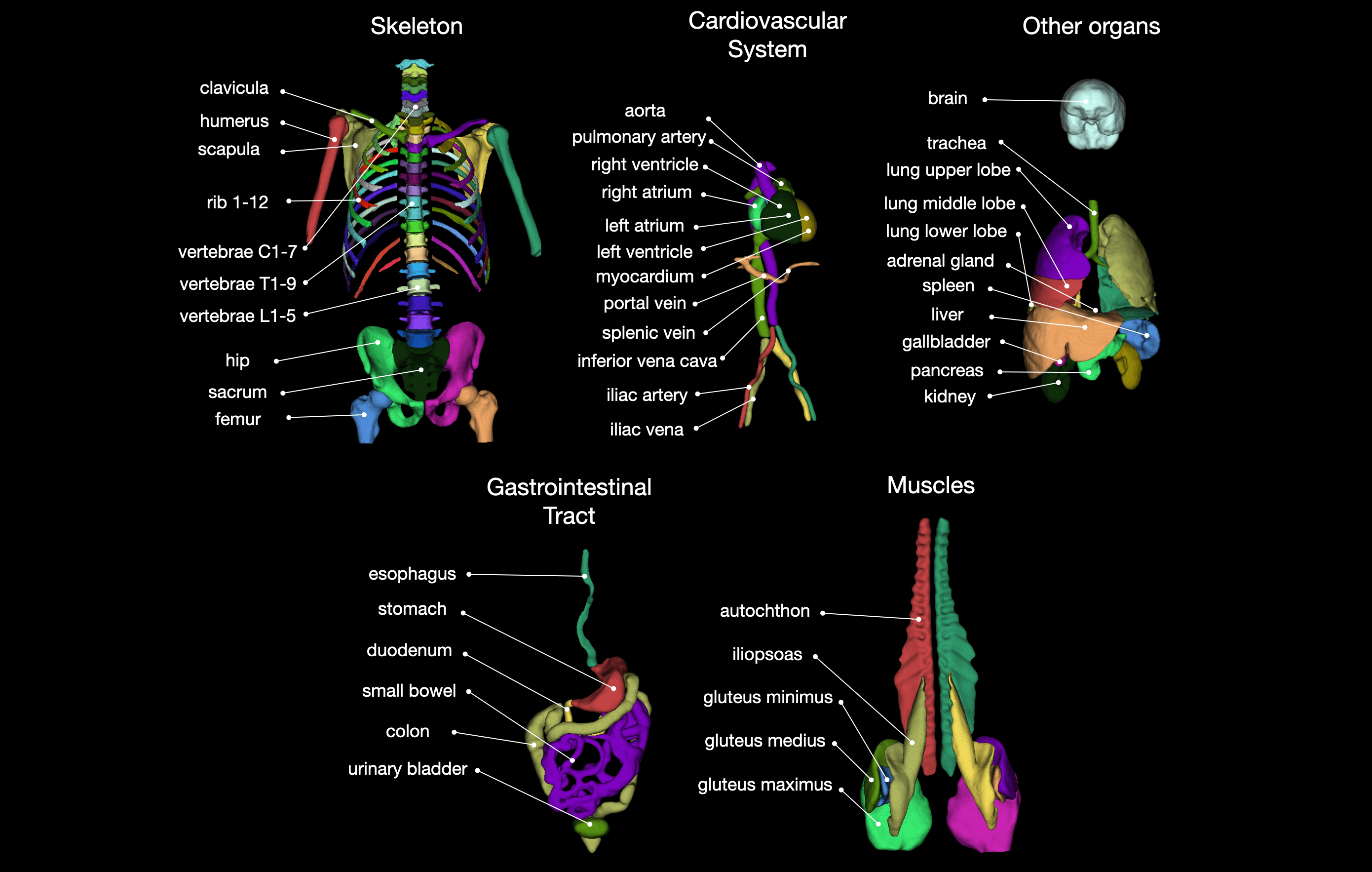Tool for segmentation of 104 classes in CT images. It was trained on a wide range of different CT images (different scanners, institutions, protocols,...) and therefore should work well on most images. The training dataset with 1204 subjects can be downloaded from Zenodo. You can also try the tool online at totalsegmentator.com.
Created by the department of Research and Analysis at University Hospital Basel.
If you use it please cite our paper: https://arxiv.org/abs/2208.05868.
TotalSegmentator works on Ubuntu, Mac and Windows and on CPU and GPU (on CPU it is slow).
Install dependencies:
-
Python >= 3.7
-
if you use the option
--previewyou have to install xvfb (apt-get install xvfb) -
You should not have any nnU-Net installation in your python environment since TotalSegmentator will install its own custom installation.
-
optionally: for faster resampling you can use
cucim(pip install cupy-cuda11x cucim)
Install Totalsegmentator
pip install TotalSegmentator
TotalSegmentator -i ct.nii.gz -o segmentations
Note: Only nifti files are supported. To convert dicom files to nifti we recommend dcm2niix.
Note: If a CUDA compatible GPU is available TotalSegmentator will automatically use it. Otherwise it will use the CPU, which is a lot slower and should only be used with the
--fastoption.
Note: You can also try it online: www.totalsegmentator.com (supports dicom files)
--fast: For faster runtime and less memory requirements use this option. It will run a lower resolution model (3mm instead of 1.5mm).--preview: This will generate a 3D rendering of all classes, giving you a quick overview if the segmentation worked and where it failed (seepreview.pngin output directory).--statistics: This will generate a filestatistics.jsonwith volume (in mm³) and mean intensity of each class.--radiomics: This will generate a filestatistics_radiomics.jsonwith radiomics features of each class. You have to install pyradiomics to use this (pip install pyradiomics).
We also provide a docker container which can be used the following way
docker run --gpus 'device=0' --ipc=host -v /absolute/path/to/my/data/directory:/tmp wasserth/totalsegmentator_container:master TotalSegmentator -i /tmp/ct.nii.gz -o /tmp/segmentations
We added some more models to TotalSegmentator beyond the default one. This allows segmentation of even more classes in more detailed subparts of the image. First you have to run TotalSegmentator with the normal settings to get the normal masks. These masks are required to crop the image to a subregion on which the detailed model will run. This is only available in the latest master branch at the moment.
TotalSegmentator -i ct.nii.gz -o segmentations --fast
TotalSegmentator -i ct.nii.gz -o segmentations -ta lung_vessels
TotalSegmentator -i ct.nii.gz -o segmentations -ta cerebral_bleed
Totalsegmentator has the following runtime and memory requirements (using a Nvidia RTX 3090 GPU):
(1.5mm is the normal model and 3mm is the --fast model)
The exact split of the dataset can be found in the file meta.csv inside of the dataset. This was used for the validation in our paper.
The exact numbers of the results for the high resolution model (1.5mm) can be found here. The paper shown these numbers in the supplementary materials figure 11.
You have to download the data and then follow the instructions of nnU-Net how to train a nnU-Net. We trained a 3d_fullres model and the only adaptation to the default training is setting the number of epochs to 4000 and deactivating mirror data augmentation. The adapted trainer can be found here.
For combining the single masks into one multilabel file you can use the function combine_masks_to_multilabel_file in totalsegmentator.libs.
If you want to combine some subclasses (e.g. lung lobes) into one binary mask (e.g. entire lung) you can use the following command:
totalseg_combine_masks -i totalsegmentator_output_dir -o combined_mask.nii.gz -m lung
pip install git+https://github.com/wasserth/TotalSegmentator.git
For more details see this paper https://arxiv.org/abs/2208.05868. If you use this tool please cite it as follows
Wasserthal J., Meyer M., Breit H., Cyriac J., Yang S., Segeroth M. TotalSegmentator: robust segmentation of 104 anatomical structures in CT images, 2022. URL: https://arxiv.org/abs/2208.05868. arXiv: 2208.05868
Moreover, we would really appreciate if you let us know what you are using this tool for. You can also tell us what classes we should add in future releases. You can do so here..

